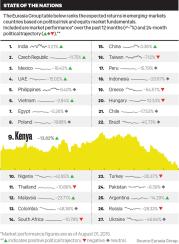On his July visit to Kenya, U.S. President Barack Obama spoke of a nation at a political and economic crossroads. Kenya is at “a moment filled with peril but enormous promise,” said Obama. The International Monetary Fund forecasts 6.5 percent growth for the year and 7.2 percent in 2016, driven by investments in infrastructure. But threats loom: Allegations of government corruption and terrorist attacks by the Islamic fundamentalist group al-Shabab, like the one that killed 148 people at a Kenyan university in April, helped slow growth in East Africa’s largest economy to 5.3 percent last year and continue to deter investors.
“The growth story long term remains intact, but there will be some short-term cyclical challenges that will exacerbate the political risks,” says Tina Byles Williams, CEO and CIO of investment management firm FIS Group in Philadelphia. Hefty fiscal and current-account deficits of 8 percent and 10 percent of gross domestic product, respectively, pressure the central bank to tighten policies to defend the shilling, which fell by 14.4 percent against the dollar in the 12 months ended August 20. This will depress growth, says Byles Williams, and squeeze the financial and services sectors that make up more than 50 percent of gross domestic product. “It’s an economy for which the trust of international investors and especially international banks and exporters is extremely important because without them Kenya won’t be able to sustain any type of growth rate,” says Ludovic Subran, Paris-based chief economist at credit insurance company Euler Hermes. Debt stands at 44 percent of GDP, roughly 10 percentage points above the regional average, but interest rate spreads are tightening, and Standard & Poor’s and Moody’s Investors Service rate Kenya at B+ and B1, respectively, with a stable outlook.
Politics also pose a challenge. President Obama cited corruption as the biggest impediment to growth and praised President Uhuru Kenyatta for prioritizing its eradication through government probes and arrests.

In the face of these headwinds, Kenyatta has been deregulating industries and boosting private sector involvement in development projects to accelerate growth. The government has also introduced an electronic customs clearance system that saves time and money for exporters. “The business community has been very pleased with the policy reforms that have been put in place since Kenyatta entered office in 2013,” says Robert Tashima, Washington-based managing editor, Africa, at London’s Oxford Business Group.
Kenya has dynamic demographics, with 75 percent of the population under the age of 30, and a diverse economy with well-developed agriculture, tourism and services sectors. The nation also boasts the continent’s highest level of financial inclusion: 75 percent of people age 15 and older have bank accounts, according to the World Bank. “On the macro level and the micro level, there’s a lot going on that is really helping improve the attractiveness of Kenya as an investment destination,” says Tashima.
The country stands to benefit too from growing trade and integration in the region, says Akin Sawyerr, Washington-based chief strategy officer at the Africa consulting firm Market Atlas. Kenya is plugged into the five-member East African Community, and Nairobi is a regional hub that hosts the African headquarters of multinational companies such as Google and PricewaterhouseCoopers.
Under Vision 2030, a development strategy initiated by Kenyatta’s predecessor, Mwai Kibaki, in 2008, the government aims to improve productivity and sustain 10 percent annual growth over the next 15 years by investing in infrastructure, education, health facilities and affordable housing. Kenya broke ground on a $25 billion Lamu Port–Southern Sudan–Ethiopia Transport Corridor project in 2012, which seeks to turn Lamu, a small island town on the country’s Indian Ocean coast, into a major port for the region. In addition to roads and railways to Ethiopia and South Sudan, the initiative calls for the construction of a pipeline to carry oil from Kenya, South Sudan and Uganda to global markets. Kenya’s oil reserves nearly doubled last year with the discovery of fields in the northwest.
“Overall the economic thesis is strong and the investor thesis for those with medium- to long-term views is still intact,” says Market Atlas’s Sawyerr.
Get more on emerging markets.






